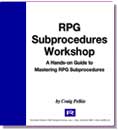|
|
| |
| NEW! |
|
ILE RPG
Subprocedures
Workshop
|
| |
|

by
Craig Pelkie |
|
| |
|
|
|
Your
RPG code can now be simpler to write, easier to maintain, readily
reused in new applications, and truly modular with ILE RPG Subprocedures
Workshop. Our new training makes using powerful ILE RPG subprocedures
easy. Nothing trendy, just solid RPG training you’ll use everyday!
ILE RPG Subprocedures Workshop gives you hands-on labs that show
you how to write practical ILE RPG subprocedures that you’ll
use every day.
The course includes a CD with all of the source code for all of
the programs, modules and service programs you'll create. There
is also source code for CL programs, commands, and other objects
used.
The course manual includes step-by-step instructions, illustrations
and easy-to-understand explanations of important techniques you'll
use over and over as you create your own subprocedures.
The course can be completed in as little as 20 hours. Just think,
in only a few days, you'll gain all of the practical knowledge you
need to develop subprocedures for your own applications.
|
| |
| Click
here for printable order form |
| |
Here's
just some of the important techniques
you'll learn in RPG Subprocedures Workshop: |
| |
- Parameter passing: by reference, by read-only reference
and by value. What do these options mean, and when should
you use a particular technique?
- How to effectively return multiple values from a subprocedure
- The mysterious "procedure pointer" -- use it to make your
code shorter, call "hidden" subprocedures in other modules
- Step-by-step: how to convert subroutines to subprocedures
- Subprocedures in a module: what you need to do when you
plan to reuse your code
- Too many modules making your compiles difficult? Learn
how to use binding directories to organize your resources
- Prototype and subprocedure, what goes where? Use this
compiler directive technique to make it simple to use your
modules
- Getting data into your subprocedures, out of it, and preserving
it: parameter lists, return values, global variables and
the STATIC keyword
|
- The dreaded "program signature violation" error -- what
it is, what it means to your service programs, and how to
use binder source to prevent it
- From module to service program: how to reuse your code
on a grand scale
You
will build your own ILE RPG
Function Generator!
When you’ve completed this course, you will have
developed your own full-feature RPG subprocedure generation
utility program. Using the generator, you’ll be able
to quickly create complete and validate subprocedure prototypes
and procedure interfaces with complete parameters lists
– just by responding to a few prompts. The generator
itself is created from RPG subprocedures that you’ll
develop as you take this self-paced 20-hour training.
You learn how to use ILE RPG subprocedures in a real-world
program, and create a utility to use for future ILE RPG
programming tasks! |
|
|
| |
|
Click
here for printable order form
|
|
|
| Contents |
| |
ILE RPG
Subprocedures Workshop will help you learn how to create and
work with subprocedures in ILE RPG programs. You'll learn how to code
subprocedures, their prototypes, and rules for passing parameters
and working with return values. You'll also create subprocedures in
modules and service programs, and work with binding directories.
Upon completion of the course, you'll have a utility program that
will help you create subprocedure prototypes. You can modify the template
of the prototype to accomodate your personal or shop standards.
Chapter 1 of the manual contains complete instructions for installing
all of the code used in the course. You can either upload the *SAVF
(Save File) object to your iSeries or you can upload individual source
files and members, using a program like Client Acess File Transfer.
You can also view all of the source code on this CD-ROM. Click any
of the chapter links to go to the page for that chapter, or click
a source file link to see the source members in the file. |
| |
Navigate
by Chapter
Chapter 1 - Install
Chapter 2 - Start PROCGEN
Chapter 3 - Subroutines to Subprocedures
Chapter 4 - Use procedure pointers
Chapter 5 - Subprocedures in a module
Chapter 6 - INCLUDE prototypes
Chapter 7 - Use a service program
Chapter 8 - Use procedure callbacks
Chapter 9 - Complete PROCGEN |
|
Navigate
by Source File
QCLLESRC
QCLSRC
QCMDSRC
QDDSSRC
QRPGBBPI
QRPGLESRC
QRPGLESRCX
QSRVSRCBBP
QTEMPLATE |
|
| |
| Note:
the minimum RPG release level for this course is V5R1. |
| |
| Click
here for printable order form |
|
|
|

